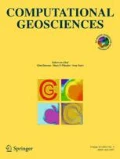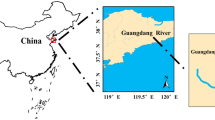Abstract
Fate and transport of heavy metals is controlled by the biogeochemical processes in the environment. Reactive transport modeling is particularly important for capturing the complex interplay between the microbial community dynamics and redox-stratified environments. The focus of this study is to investigate the impacts of (i) multicomponent diffusion (MCD) and (ii) electrical double layer (EDL) on reactive diffusive transport of heavy metals at Lake Coeur d’Alene (LCdA) sediments. The solute benthic fluxes at LCdA sediments are controlled by diffusion, and therefore, the biogeochemical model is focused purely on diffusive transport. In diffusive transport-dominated multicomponent systems, species-specific multicomponent diffusion (i.e., Nernst-Planck representation of diffusion) and the explicit treatment of electrostatic effects can play an important role on the overall dynamics of biogeochemical cycling of metals in the system. The results of this study demonstrate that the use of single uniform diffusion coefficient for all species in purely diffusion-dominated sediments may underestimate the mobility of heavy metals undergoing complex reaction network. This outcome is further signified when explicit treatment of EDL effects is considered in addition to MCD. The simulation results also illustrate the importance of aqueous metal (bi)sulfide complexes, especially when MCD and EDL effects are implemented in reactive transport simulations, impacting the solubility and dynamics of heavy metals in diffusion-dominated systems. The competitive effects of Fe-reducing bacteria FRB and sulfate reducing bacteria SRB activities on pH and overall biogeochemical processes are also demonstrated with multispecies diffusion and explicit treatment of electrostatic effects in the system.
Similar content being viewed by others
References
Gevao, B., Hamilton-Taylor, J., Murdoch, C., Jones, K.C., Kelly, M., Tabner, B.J.: Depositional time trends and remobilization of PCBs in lake sediments. Environ. Sci. Technol. 31, 3274–3280 (1997)
Santschi, P.: Radionuclides as tracers for sedimentation and remobilization. In: Sly, P.G. (ed.) Sediments and water interactions, pp. 437–449. Springer-Verlag, New York (1986)
Gallon, C., Tessier, A., Gobeil, C., Alfaro-De La Torre, M.C.: Modeling diagenesis of lead in sediments of a Canadian Shield lake. Geochim. Cosmochim. Acta. 68(17), 3531–3545 (2004)
Canavan, R.W., Van Cappellen, P., Zwolsman, J.J.G., Van den Berg, G.A., Slomp, C.P.: Geochemistry of trace metals in a freshwater sediment: field results and diagenetic modeling. Sci. Total Environ. 381(1), 263–279 (2007)
Wu, G., Li, L.Y.: Modeling of heavy metal migration in sand/bentonite and the leachate pH effect. J. Contam. Hydrol. 33(3), 313–336 (1998)
Boyle, J.: Redox remobilization and the heavy metal record in lake sediments: a modeling approach. J. Paleolimnol. 26(4), 423–431 (2001)
Couture, R.M., Shafei, B., Van Cappellen, P., Tessier, A., Gobeil, C.: Non-steady state modeling of arsenic diagenesis in lake sediments. Environ. Sci. Technol. 44(1), 197–203 (2009)
Torres, E., Ayora, C., Jiménez-Arias, J.L., García-Robledo, E., Papaspyrou, S., Corzo, A.: Benthic metal fluxes and sediment diagenesis in a water reservoir affected by acid mine drainage: a laboratory experiment and reactive transport modeling. Geochim. Cosmochim. Acta. 139, 344–361 (2014)
Torres, E., Couture, R.M., Shafei, B., Nardi, A., Ayora, C., Van Cappellen, P.: Reactive transport modeling of early diagenesis in a reservoir lake affected by acid mine drainage: trace metals, lake overturn, benthic fluxes and remediation. Chem. Geol. 419, 75–91 (2015)
Torres, E., Galván, L., Cánovas, C.R., Soria-Píriz, S., Arbat-Bofill, M., Nardi, A., Papaspyrou, S., Ayora, C.: Oxycline formation induced by Fe (II) oxidation in a water reservoir affected by acid mine drainage modeled using a 2D hydrodynamic and water quality model—CE-QUAL-W2. Sci. Total Environ. 562, 1–12 (2016)
Şengör, S.S., Spycher, N.F., Ginn, T.R., Sani, R.K., Peyton, B.: Biogeochemical reactive–diffusive transport of heavy metals in Lake Coeur d’Alene sediments. Appl. Geochem. 22(12), 2569–2594 (2007)
Van Cappellen, P., Gaillard, J.-F.: Biogeochemical dynamics in aquatic sediments. In: Lichtner, P.C., Steefel, C.I., Oelkers, E.H. (eds.) Reactive transport in porous media, pp. 335–376. Mineralogical Society of America, Washington, D.C. (1996)
Boudreau, B.P.: Diagenetic models and their implementation. Modeling transport and reactions in aquatic sediments. Springer-Verlag, Heidelberg (1997)
Appelo, C.A.J., Wersin, P.: Multicomponent diffusion modeling in clay systems with application to the diffusion of tritium, iodide, and sodium in Opalinus clay. Environ. Sci. Technol. 41(14), 5002–5007 (2007)
Appelo, C.A.J., Van Loon, L.R., Wersin, P.: Multicomponent diffusion of a suite of tracers (HTO, Cl, Br, I, Na, Sr, Cs) in a single sample of Opalinus clay. Geochim. Cosmochim. Acta. 74(4), 1201–1219 (2010)
Ghorayeb, K., Firoozabadi, A.: Modeling multicomponent diffusion and convection in porous media. SPE J. 5(02), 158–171 (2000)
Furrer, G., Wehrli, B.: Microbial reactions, chemical speciation, and multicomponent diffusion in porewaters of a eutrophic lake. Geochim. Cosmochim. Acta. 60(13), 2333–2346 (1996)
Liang, Y., Richter, F.M., Chamberlin, L.: Diffusion in silicate melts: III. Empirical models for multicomponent diffusion. Geochim. Cosmochim. Acta. 61(24), 5295–5312 (1997)
Fornasiero, F., Prausnitz, J.M., Radke, C.J.: Multicomponent diffusion in highly asymmetric systems. An extended Maxwell-Stefan model for starkly different-sized, segment-accessible chain molecules. Macromolecules. 38(4), 1364–1370 (2005)
Désilets, M., Proulx, P., Soucy, G.: Modeling of multicomponent diffusion in high temperature flows. Int. J. Heat Mass Transf. 40(18), 4273–4278 (1997)
Giovangigli, V.: Multicomponent flow modeling. Sci. China Math. 55(2), 285–308 (2012)
Wang, Y., Van Cappellen, P.: A multicomponent reactive transport model of early diagenesis: application to redox cycling in coastal marine sediments. Geochim. Cosmochim. Acta. 60(16), 2993–3014 (1996)
Zorrilla, S.E., Rubiolo, A.C.: A model for using the diffusion cell in the determination of multicomponent diffusion coefficients in gels or foods. Chem. Eng. Sci. 49(13), 2123–2128 (1994)
Cussler, E.L.: Multicomponent diffusion. Elsevier (2013)
Turner, J.S.: Double-diffusive phenomena. Annu. Rev. Fluid Mech. 6(1), 37–54 (1974)
Parkhurst, D.L., Appelo, C.A.J.: Description of input and examples for PHREEQC version 3: a computer program for speciation, batch-reaction, one-dimensional transport, and inverse geochemical calculations (No. 6-A43). US Geological Survey (2013)
Appelo, C.A.J., Vinsot, A., Mettler, S., Wechner, S.: Obtaining the porewater composition of a clay rock by modeling the in-and out-diffusion of anions and cations from an in-situ experiment. J. Contam. Hydrol. 101(1), 67–76 (2008)
Muniruzzaman, M., Rolle, M.: Impact of multicomponent ionic transport on pH fronts propagation in saturated porous media. Water Resour. Res. 51(8), 6739–6755 (2015)
Bear, J.: Dynamics of fluids in porous materials. Society of Petroleum Engineers (1972)
Bard, A.J., Faulkner, L.R.: Fundamentals and applications. Electrochem. Methods. 2, (2001)
Steefel, C.I., Maher, K.: Fluid-rock interaction: a reactive transport approach. Rev. Mineral. Geochem. 70, 485–532 (2009). https://doi.org/10.2138/rmg.2009.70.11
Steefel, C.I., Mayer, K.U., Arora, B., Appelo, C.A.J., Hammond, G., Jacques, D., Kolditz, O., Lagneau, V., Lichtner, P.C., Meussen, H., Molins, S., Parkhurst, D.L., Shao, H., Simŭnek, J., Van der Lee, J., Yabusaki, S.B., Yeh, G.T.: Reactive transport codes for subsurface environmental simulation. Comput. Geosci. (2014) submitted
Alt-Epping, P., Tournassat, C., Rasouli, P., Steefel, C.I., Mayer, K.U., Jenni, A., Mäder, U., Sengor, S.S., Fernández, R.: Benchmark reactive transport simulations of a column experiment in compacted bentonite with multispecies diffusion and explicit treatment of electrostatic effects. Comput. Geosci. 19(3), 535–550 (2015)
Steefel, C.I., Yabusaki, S.B., Mayer, K.U.: Reactive transport benchmarks for subsurface environmental simulation. Comput. Geosci. 19(3), 439 (2015)
Ullman, W.J., Aller, R.C.: Diffusion coefficients in nearshore marine sediments. Limnol. Oceanogr. 27(3), 552–556 (1982)
Balistrieri, L.S.: Preliminary estimates of benthic fluxes of dissolved metals in Coeur d'Alene Lake, Idaho. US Department of the Interior, US Geological Survey (1998)
Winowiecki, L.: Geochemical cycling of heavy metals in the sediment of Lake Coeur d’Alene, Idaho. Masters Thesis, University of Idaho, Moscow, Idaho (2002)
Russell, E.W.: Soil conditions and plant growth, 473p. Longmans Publishing, London (1973)
Parkhurst, D.L., Appelo, C.A.J.: User’s guide to PHREEQC (version 2)—a computer program for speciation, batchreaction, one-dimensional transport, and inverse geochemical calculations. US Geol. Surv. Water-Resour. Investig. Rep. 99-4259, Denver, CO (1999)
Doussan, C., Poitevin, G., Ledoux, E., Detay, M.: River bank filtration: modelling of the changes in water chemistry with emphasis on nitrogen species. J. Contam. Hydrol. 25, 129–156 (1997)
Brugato, C., 1999. Mathematical modeling of an anaerobic syntrophic butyrate-degrading coculture. Masters Thesis, University California, Davis
Arora, B., Şengör, S.S., Spycher, N.F., Steefel, C.I.: A reactive transport benchmark on heavy metal cycling in lake sediments. Comput. Geosci. 19(3), 613–633 (2015)
Buffle, J., Zhang, Z., Startchev, K.: Metal flux and dynamic speciation at (bio) interfaces. Part I: critical evaluation and compilation of physicochemical parameters for complexes with simple ligands and fulvic/humic substances. Environ. Sci. Technol. 41(22), 7609–7620 (2007)
Şengör S.S., Spycher N., Ginn T.R., Moberly J.G., Peyton B., Sani R.K., 2007. Reductive dissolution and metal transport in Lake Coeur d’Alene sediments. In Water-rock interaction, WRI-12 (Bullen T. and Wang Y., eds.), vol. 2. Taylor & Francis Group, London, pp. 895–899
Author information
Authors and Affiliations
Additional information
Publisher’s note
Springer Nature remains neutral with regard to jurisdictional claims in published maps and institutional affiliations.
Rights and permissions
About this article
Cite this article
Li, J., Şengör, S.S. Biogeochemical cycling of heavy metals in lake sediments: impact of multispecies diffusion and electrostatic effects. Comput Geosci 24, 1463–1482 (2020). https://doi.org/10.1007/s10596-019-09915-7
Received:
Accepted:
Published:
Issue Date:
DOI: https://doi.org/10.1007/s10596-019-09915-7




